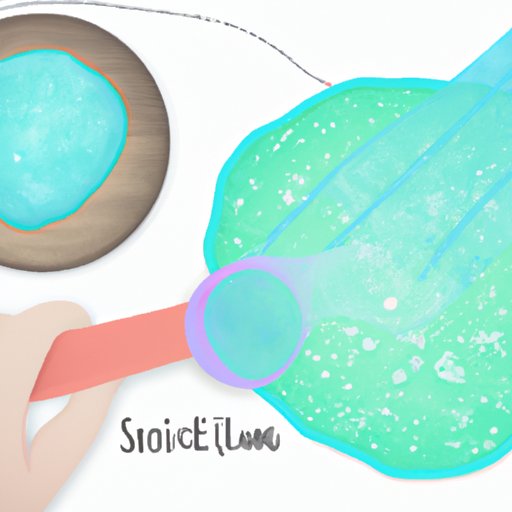
Introduction
If you’re looking for a fun and slimy activity to do with your kids, you can’t go wrong with stretchy slime. But making the perfect stretchy slime can be a challenge. Maybe it’s too sticky, or too runny, or not stretchy enough. Fear not, for we have put together a comprehensive guide to making stretchy slime that will have you and your family stretching and pulling to your hearts’ content.
In this article, we’ll provide step-by-step instructions that break down the process of making stretchy slime into smaller, more manageable steps. We’ll also include a short video tutorial, explore different types of slime, turn the slime-making process into a fun and educational science experiment, provide ingredient substitutes, and share tips for avoiding common mistakes.
Step-by-Step Tutorial
Let’s get started on making some stretchy slime! Here’s what you’ll need:
– ½ cup of white school glue
– ½ cup of water
– ½ tsp baking soda
– 1 tbsp contact lens solution
– Food coloring (optional)
– Mixing bowl
– Spoon
– Measuring cup
– Sealable plastic bag or container
Now let’s get to it:
1. Pour the ½ cup of white school glue into your mixing bowl.
2. Add ½ cup of water to the glue and mix until well combined.
3. If you want, add a few drops of food coloring to the glue mixture and stir.
4. Add ½ tsp of baking soda to the mixture and stir.
5. Pour 1 tbsp of contact lens solution into the bowl and mix well.
6. Keep mixing until the slime starts to come together and becomes difficult to stir.
7. Use your hands to knead the slime in the bowl for several minutes to get it to the desired consistency.
8. If the slime is too sticky, add more contact lens solution, a few drops at a time, and knead until you get the right consistency.
9. When the slime is stretchy and no longer sticks to your hands or the bowl, store it in a sealable plastic bag or container.
Video Tutorial
If you need a visual guide, we’ve got you covered. Check out our video tutorial that walks you through the process of making stretchy slime step-by-step. Sometimes seeing someone else make something is more effective than reading about it, so don’t be afraid to use this video as a resource.
Different Types of Slime
Now that you’ve mastered the art of making stretchy slime, let’s explore some different types of slime you can make. Here are three types to get you started:
1. Foam Slime – To make foam slime, simply add shaving cream to your glue mixture before you add the baking soda and contact lens solution. This will give your slime a foamy texture that’s fun to play with.
2. Glitter Slime – For glitter slime, just add glitter to your glue mixture before you add the baking soda and contact lens solution. The more glitter you add, the sparklier your slime will be.
3. Crunchy Slime – To make crunchy slime, simply add small beads or plastic pellets to your glue mixture before you add the baking soda and contact lens solution. This will give your slime a fun, crunchy texture.
A Science Experiment
Did you know that making slime is also a great science experiment? Here’s how to turn it into one:
As you’re making your stretchy slime, you can explain to your kids how the different ingredients work together to create the slime. For example, the glue contains a liquid polymer that acts as the “glue” that combines with the borax in the contact lens solution to form the slime. You can also talk about the chemical reactions that happen when you mix the ingredients together.
After you’ve made your slime, you can get even more scientific by experimenting with different amounts of ingredients to see how it affects the texture and stretchiness of your slime.
Ingredient Substitutes
Don’t have all the ingredients on hand? No problem, you can still make slime with some ingredient substitutes. Here are a few options:
1. Instead of white school glue, you can use clear school glue, which will give your slime a more translucent appearance.
2. If you don’t have contact lens solution, you can use saline solution instead. Just make sure it contains boric acid and sodium borate.
3. You can also use laundry detergent in place of contact lens solution. Just add it gradually until you get the desired consistency.
Common Mistakes and How to Avoid Them
Even though we’ve given you a step-by-step tutorial, making slime can sometimes lead to a few common mistakes. Here are some tips for avoiding them:
1. Make sure all your measurements are precise. Too much or too little of any of the ingredients can throw off the consistency of your slime.
2. If your slime is too sticky, try adding more contact lens solution gradually until you get the right consistency.
3. If your slime is too runny, you may have added too much contact lens solution. Try adding a bit more glue to thicken it up.
4. Don’t leave your slime out for too long as it can dry out and become less stretchy over time. Keep it in a container or bag when not in use.
Conclusion
With our step-by-step tutorial, video tutorial, exploration of different slime types, science experiment, ingredient substitutes, and tips for avoiding common mistakes, you should be well on your way to making the perfect stretchy slime. Remember to let your creativity run wild and experiment with different types of slime to find the one that’s right for you.





